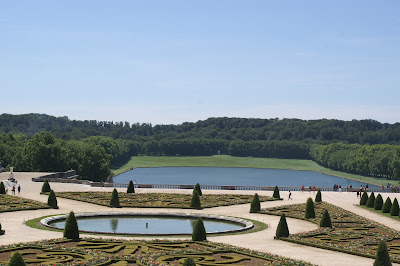It was our last full day in Paris. So after dining on light, flaky sacristain (LOVE those!!) and other pastries for breakfast…
Image by: Jack06
We travelled to the Palace of Versailles!
The line to get in was over two hours long. (Naturally!)
And I could see Chris already shaking his head, preparing to leave. But I was desperate! Approaching the entrance security guard, I summoned the skills earned from my single year of college French. I indicated the line and said, “Pardon monsieur, mais est-il une autre option?
“Oui!” he replied. Then in really great English, he explained we could save time by purchasing our tickets from a restaurant directly across the street. Dashing between cars, we bought the tickets, dashed back and made it inside the palace within 45 minutes!
The intriguing story behind this opulent structure is this: In 1661, King Louis XIV’s finance minister, Nicolas Fouquet invited the king for a weekend of lavish entertainment at his luxurious new château. Twenty-two-year-old Louis felt his authority was being undermined by Fouquet’s show of wealth, so after the festivities, he had Fouquet tossed in prison on trumped-up charges, then hired his talented building team to start work on what later became the Palace of Versailles. Louis wanted his palace to embody the divine majesty and absolute power of the French monarchy; it took 20 years and over 30,000 men to build.
Years later, Louis XVI and Marie-Antoinette’s extravagant taste in decorating—which is apparent throughout this incredible structure—along with Louis’ military campaigns abroad, eventually drained the royal treasury, inspiring revolution and the end of Versailles as the royal seat of power.
Versailles Chapel
Many of the rooms are named after Roman gods and goddesses. Here is a famous Bernini bust of Louis XIV in the Salon de Diane. (Diana Room—Roman goddess of the hunt.)
Since I’d just finished reading Diana Gabaldon’s historical Outlander series, which incorporates this palace into the events of one of the stories, I was thrilled to see the glittering Galerie des Glaces (Hall of Mirrors) for myself.
It’s renowned as one of the most famous rooms in the world, holding 17 mirror-clad arches—each with 21 mirrors—reflecting the 17 arcaded windows overlooking the amazing Versailles gardens.
I could just envision the room at night, lit by hundreds of candles. Dancers swirling past in beautiful gowns of colorful silk…
It did not disappoint!
“Hey Josh,” I said as I squinted through my camera viewfinder, snapping photo after photo. “Did you know that it was in this very room that Otto Bismarck proclaimed the unified German Empire in 1871? Then ironically the Treaty of Versailles declaring Germany’s responsibility for World War I was signed here in 1919.”
“That’s interesting, mom.” Josh said. “I’m going to go check out that beautiful garden view from the window.” He was off in a flash. That’s strange. Josh never cares about beautiful garden views at home.
Aside from the Hall of Mirrors, I was most thrilled to tour the amazing gardens of Versailles. Arguably the most famous gardens in the world…
Designed by Andre Le Nôtre between 1661 and 1700, the lawns are painstakingly manicured featuring parterres of flowers, sculptures and fountains in classic French Baroque style.
That’s the Grand Canal. It’s an original creation of Le Nôtre, and was the setting for King Louis XIV’s nautical spectacles. In the summer, his fleet of reduced model ships sailed its length.
We found the sculpted shrubbery most inspiring.
Good times, good times.
Arriving back in Paris, we wandered the banks of the Seine, browsing the treasure-filled iconic “green boxes” of the outdoor booksellers, or bouquinistes.
The bouquinistes have been a Parisian tradition since the 16th century, and you can often spot them in famous Paris landscapes, particularly from the Impressionist period.
Pariser Büchermarkt (Bouquinistes)
Creator:Fritz Westendorp (1867 Köln – 1926 Düsseldorf)
Image by: AndreasPraefcke
Deciding the evening was still young, we took a sunset river cruise down the Seine.
With vintage French accordion music as our backdrop, we viewed the famous bridges of Paris.
(Okay, this guy isn’t exactly “vintage” but this is a good sample of the type of music we listened to so you can get the full effect:
This shot was taken on dry land, but here we have Paris’ controversial “Love Locks.”
Apparently couples inscribe their names on padlocks and attach them to the wire-mesh bridge railings, then toss the key into the Seine below in a poetic declaration of everlasting love. Aaaah, le romance! (Or vandalism, depending on your point of view.)
It was such a beautiful Sunday evening. Parisians relaxed by the riverside waving, playing music and blowing us kisses as we passed…
It was the perfect end to our final night in Paris.
Tune in next week for my final Parisian post!
All photographs © Holly, Chris & Ashleigh Bowne unless otherwise noted.
































3 comments:
I love that the little book stalls are so vintage that they are in famous paintings. Now that is neat.
What a wonderful vacation. The hall of mirrors is extremely elegant and beautiful.
The "ancientness" (I know, not a word!) of everything really was so cool. It's something we don't get to experience so much in our relatively "young" U.S.A.
I love how you find out other means to by-pass the lines! Good to know too for anyone else who'll be going to those places soon. :)
Versailles was so over-the-top, but amazing to see. I remember looking at the Hall of Mirrors in awe because it was a relatively new technology at that point and yet they were still done pretty darned well.
What a wonderful last day in Paris you had!
Post a Comment